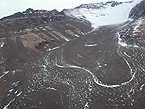Separated at Birth
May 9, 2010

It turns out that the newly discovered deposits of water ice on Mars, called lobate debris aprons, are very similar to rock covered glaciers in Antarctica.
In 2000, Jack Holt and Don Blankenship, also an ice sheet expert at the Institute, were in Antarctica testing a new radar developed by NASA as a prototype for a future mission to Europa. They installed the radar in an aircraft with other aerogeophysical instruments and flew the system over Antarctica’s Dry Valleys. Holt hoped to detect buried ice deposits in Beacon and Taylor valleys. In Beacon Valley there are features that appear to be either rocky debris flows lubricated with a small amount of ice, or possibly rock-covered glaciers.
When he analyzed the radar data, Holt was disappointed to find that surface clutter, a kind of noise caused by reflections from the rough surface of the valley floor and from surrounding walls, made it virtually impossible to make out true features below the surface. That experience spurred him to begin developing techniques for discriminating between this noise and the subsurface signal, techniques that he more fully developed with the Mars radar data that led to the discovery of vast new glaciers.
When Holt conducted this work at Beacon Valley, scientists generally thought the deposits were mostly rock with a little ice. More recently, though, seismic studies, ground-penetrating radar and drill cores have revealed that glaciers lie below the rocky surface.
“Kind of odd that people figured out what Beacon Valley ‘rock glaciers’ really were about the same time as we discovered what the ‘lobate debris aprons’ really are on Mars,” said Holt.
Ironically, he said, it’s actually much easier to study ice on Mars than on Earth.
“I can basically choose where to acquire new radar data at my desk, maybe with a teleconference follow up, then I can analyze it and write up the results all in my office, with perhaps a few students helping out,” he said. “Of course many people are involved in the data acquisition, all over the world, but I personally don’t have to go anywhere or do anything special other than choose and justify the targets.”
“For Earth, I have to get a comprehensive physical exam, spend months planning with about a dozen other people to deploy an instrument-filled aircraft in Antarctica, and spend a long time away from home in difficult conditions,” he continued. “That is just to get the data. So Mars is far and away a better payoff on the time investment.”
Still, he noted that to fully understand Mars you have to understand Earth. And there are many excellent reasons for studying ice on Earth, including the potential for sea level rise as climate changes.
by Marc Airhart
>>> Return to “Hunting Hidden Glaciers”
For more information about the Jackson School contact J.B. Bird at jbird@jsg.utexas.edu, 512-232-9623.
